Primuna™ – Priming the Immune System
Primuna™ with Wellmune® is clinically proven to strengthen the immune system by boosting billions of immune cells that help keep the body healthy. Primuna-activated immune cells are primed and ready to respond more quickly as needed, helping to support the immune system as we age. Primuna is a safe and effective ingredient for those concerned about a healthy immune system at any age.
The scientific understanding of Primuna’s mechanism of action in the body is well documented in published, peer-reviewed research. Mechanism of action studies as well as measurement of significant changes in immune responses are changing the way the scientific community thinks about innate immune function.
Once swallowed, immune cells in the gastrointestinal tract take up Primuna and transport it to immune organs throughout the body.
- While in the immune organs, immune cells called macrophages digest Primuna into smaller fragments and slowly release them over a number of days.
- The fragments bind to neutrophils, via complement receptor 3 (CR3), which are the most abundant immune cells in the body. In fact, neutrophils account for 40-60% of all immune cells.
- Primuna primes and strengthens the key immune function of neutrophils that now more quickly move throughout the body to sites of infection and destroying the pathogenic microorganisms like bacteria and viruses.
Unlike other immune health ingredients, Primuna boosts immune function without over-stimulating the immune system, a key concern with some other natural immune boosters such as Echinacea which is not recommended for long term use.
Primed neutrophils rush to the site of infection or inflammation. They also play a role of recruiting and activating other types of immune cells in a coordinated response. Further, primed neutrophils present fragments of the destroyed pathogens to the adaptive immune system so the body can be prepared to respond quickly to a similar challenge.
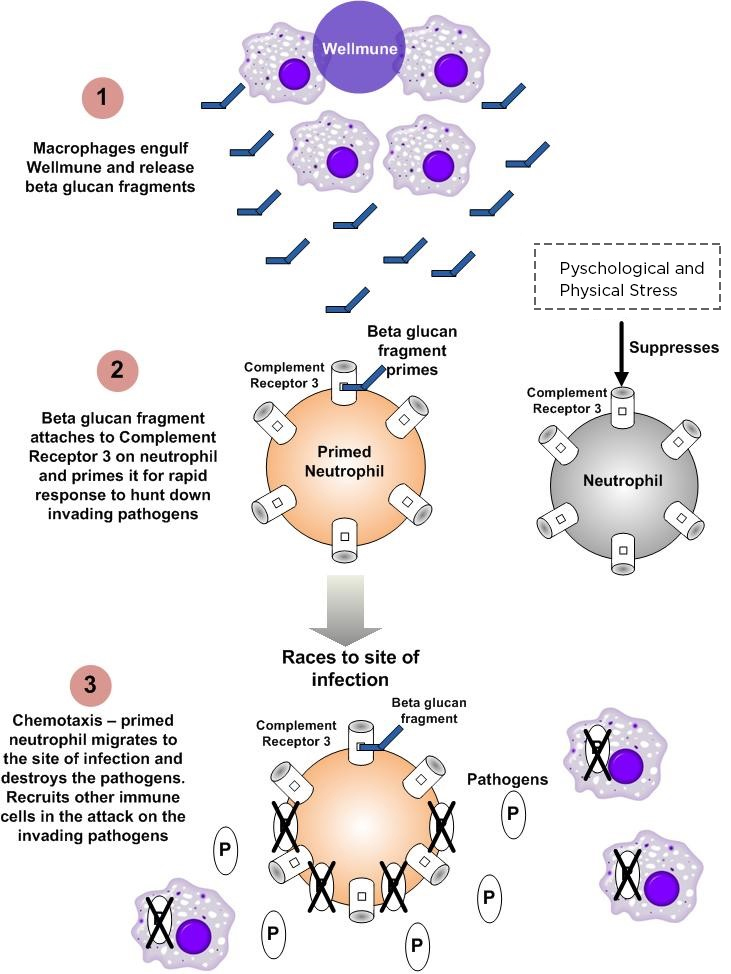
The Under Appreciated Neutrophil.
Understanding of neutrophil immunobiology has evolved since their initial discovery by Nobel Prize winner Elie Metchnikoff in 1882. Once thought of as rude and unrefined soldiers of the immune defense system, whose successful mission often included collateral tissue damage, are now seen precise and sophisticated sharp shooters against invading pathogens.1
The “Stress” Factor
Stress has been implicated as the one of the environmental factors that can challenge the immune system’s ability to attack and vanquish invading pathogenic microorganisms (bacteria, viruses).
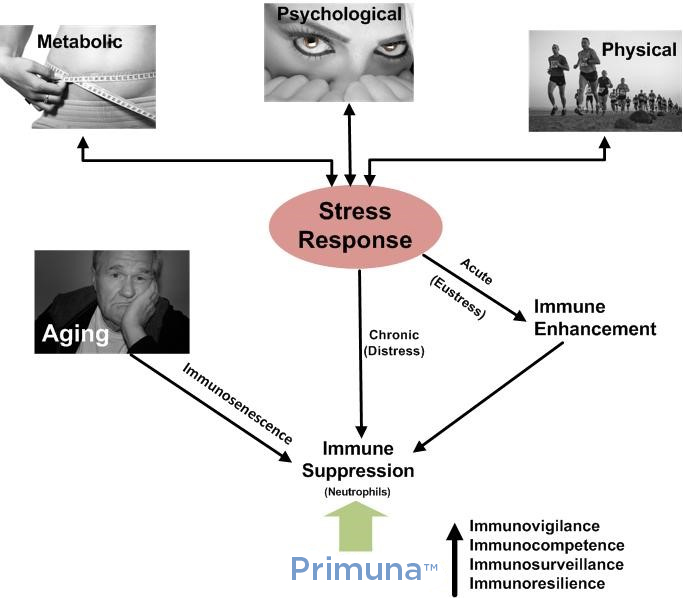
Primuna– Shown to help stressed immune systems
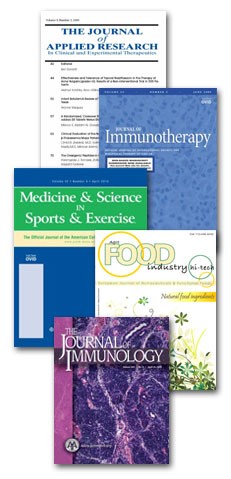 Occasional stress on the immune system can come from many sources, psychological stress, and physical stress including intense exercise. Stress can impact the immune system, and Primuna can help.
Occasional stress on the immune system can come from many sources, psychological stress, and physical stress including intense exercise. Stress can impact the immune system, and Primuna can help.
In three previously published clinical trials, Primuna’s beta-1,3/1,6-glucan derived from bakers yeast (beta-glucan) has been shown to reduce the severity and duration of upper-respiratory tract infection symptoms in healthy subjects2 physically stressed subjects3 and healthy-stressed subjects.4 The mechanism of action by which beta-glucan enhances the activity of innate immune cells has been extensively described5-7 with increased survival in animals challenged with a variety of pathogens in vivo.8-10
Strenuous exercise, while highly beneficial to our bodies, is also a key stressor to the immune system. For example, a drop in the immune system’s white blood cells can occur following intense exercise. Primuna has been shown to prevent this drop and maintain white blood cell levels.11 Similarly, Primuna was found to help Mucosal Immunity by allowing levels of salivary IgA, a protective protein associated with improved immune protection of the mucosa, to rebound more quickly after exercise.11 A study of marathon runners found that runners taking Wellmune while training experienced a >34% reduction in training days lost to upper respiratory tract infections such as cold and flu.12 By priming the immune system to handle the stress of exercise, Primuna can help athletes maximize their training by limiting training days lost to illness.
Occasional Psychological Stress
Psychological Stress & The Immune System
The relationship between stress and decreased immune function is well established 14-16 with psychological stress having been shown to negatively impact health.16-1 Psychological stress can alter immune cell populations, lowers antibody production, and alters cytokine responses.19-2015-17
Physical Stress
Strenuous aerobic exercise or a physically exhaustive work session are known to disrupt innate immune function for up to 24 hours.21, 22 Environmental extremes exacerbate the typical exercise response and may further weaken the immune system.23 Reduction in mucosal immunity, in addition to altered innate immune cells, results in an ‘open window’24 where an individual may be more susceptible to infections. Both natural killer cells and monocytes contribute to the innate immune response and are altered during recovery from exercise.22, 25, 26
Becoming ill after exercise can result in lost training days, reductions in performance and lost working days. In the case of physical laborers, police officers, firefighters and soldiers, such sickness may increase the risk of job-related injuries and fatalities due to fatigue.
Immunosenescence: The Aging Immune System
Anyone over age 60 should pay particular attention to supporting their immune system function. Humans can experience a weakening of the immune system as they age. This process is called immunosenescence.27 One study found that flu vaccines were only 30-40% effective in elderly patients due to reduced systemic immune system function (immunosenescence).28 Several studies indicate that an important factor in immunosenescence is the reduced capacity of macrophages and neutrophils.29-31 Wellmune works specifically by priming the neutrophils and therefore may play a crucial role in strengthening the immune system for anyone over age 60.
Our understanding of immunosenescence is still growing, but it is clear that many parts of the immune system reduce their function in a way that makes it harder for us to fight off illness as we grow older. The body produces fewer immune cells, communication between cells breaks down and responses to health challenges diminishes. The slow decline of immune function can significantly impact overall health, vitality and appearance.
No one yet understands all the mechanisms behind immunosenescence, but oxidative damage is among the main suspects.36, 37 With loss of an appropriate response to a threat, you become more vulnerable.33 Vaccines don’t “take” as readily. And if you had chicken pox in childhood, the latent virus reemerges to cause the painful and unsightly rash of shingles.38, 39 Many immunologists see shingles as a classic illustration of immunosenescence.
Primuna™ Clinical Research – Evolving and Current Science
Wellmune, Primuna’s primary ingredient, is the product of over $300 million in research including many human clinical trails. The first-hand science clinical research portfolio on Wellmune is one of the most extensive in the nutraceutical industry.
Wellmune human clinical trials have validated statistically significant benefits using the recommended daily dose of 250 mg, the same as used in Primuna.
2014
- Yeast-Derived 1,3/1,6 Glucopolysaccharide to Prevent Upper Respiratory Tract Infection and Modulate Circulating Cytokines and Chemokines in Older Adults
- Formula Consumption in 3- to 4-Year-Olds and Respiratory Infections: An RCT
- Formula with docosahexaenoic acid, prebiotics, and beta-glucan supports respiratory and skin health in children
- Differential regulation of oxidative burst by distinct ?-glucan-binding receptors and signaling pathways in human peripheral blood mononuclear cells
2013
- Baker’s Yeast Beta Glucan Supplementation Increases Salivary IgA and Decreases Cold/Flu
- Symptomatic Days After Intense Exercise
- Baker’s Yeast Beta-Glucan Supplement Reduces Upper Respiratory Symptoms and
- Improves Mood State in Stressed Women
- ?-Glucan supplementation and quality of life
2012
- Baker’s Yeast Beta Glucan Supplementation Reduces The Number Of Cold/Flu Symptomatic Days After Completing A Marathon
- Baker’s yeast ?-glucan supplementation increases monocytes and cytokines post-exercise: implications for infection risk?
- Influence of yeast-derived 1,3/1,6 glucopolysaccharide on circulating cytokines and chemokines with respect to upper respiratory tract infections.
2011
- The Effects of Yeast ?-Glucan Supplementation on Monocyte and Cytokine Response to Exercise. Presented at the International Society of Exercise Immunology, University of Oxford
- Baker’s Yeast Beta-Glucan Supplement Reduces Allergy Symptoms and Improves Quality of Life in Ragweed Sufferers. Presented at Experimental Biology 2011, Washington, D.C.
2010
- Beta-Glucan Supplement Reduces URTIs & Improves Mood State in Stressed Women. Presented to the American College of Nutrition
- Beta-glucan Supplement Reduces Upper Respiratory Tract Infections and Improves Mood State in Healthy Stressed Subjects. Presented at Experimental Biology 2010 in Anaheim, Calif.
- Beta 1,3/1,6 Glucan Decreases Upper Respiratory Tract Infection Symptoms and Improves Psychological Well-Being in Moderate to Highly-Stressed Subjects. Agro Food Industry Hi-Tech (2010) 21:21-24.
2009
- Effect of Beta 1,3/1,6 Glucan on Upper Respiratory Tract Infection Symptoms and Mood State in Marathon Athletes. Journal of Sports Science and Medicine (2009). 8:509-515.
- Randomized Phase II Clinical Trials of Wellmune WGP® for Immune Support During Cold and Flu Season. The Journal of Applied Research (2009) 9:20-42.
2008
- Effects of an Immunomodulating Supplement on Upper Respiratory Tract Infection Symptoms in Wildland Firefighters. Medicine & Science in Sports & Exercise. 40(5):S353.
Appendix A: References
- Kumar V, Sharma. Neutrophils: Cinderella of innate immune system. Intl Immunopharmacology; 10(2010):1325-1334.
- Feldman S, Schwartz HI, Kalman DS, Mayers A, Kohrman H.M, Clemens R, Krieger DR: Randomized phase II clinical trials of Wellmune WGPt for immune support during cold and flu season. J Appl Res 9:30–42, 2009.
- Talbott S, Talbott J: Effect of BETA 1, 3/1, 6 glucan on upper respiratory tract infection symptoms and mood state in marathon athletes. J Sports Sci Med 8:509–515, 2009.
- Talbott S, Talbott J: Beta 1,3/1,6 glucan decreases upper respiratory tract infection symptoms and improves psychological well-being in moderate to highly-stressed subjects. Agro Food Ind Hi Tech 21:21–24, 2010.
- Bedirli A, Kerem M, Pasaoglu H, Akyurek N, Tezcaner T, Elbeg S, Memis L, Sakrak O: Beta-glucan attenuates inflammatory cytokine release and prevents acute lung injury in an experimental model of sepsis. Shock 27:397–401, 2007.
- Ikewaki N, Fujii N, Onaka T, Ikewaki S, Inoko H: Immunological actions of Sophy beta-glucan (beta-1,3-1,6 glucan), currently available commercially as a health food supplement. Microbiol Immunol 51:861–873, 2007.
- Hong F, Yan J, Baran JT, Allendorf DJ, Hansen RD, Ostroff GR, Xing PX, Cheung NK, Ross GD: Mechanism by which orally administered b-1,3-glucans enhance the tumoricidal activity of antitumor monoclonal antibodies in murine tumor models. J Immunol 173:797–806, 2004.
- Liang J, Melican D, Cafro L, Palace G, Fisette L, Armstrong R, Patchen ML: Enhanced clearance of a multiple antibiotic resistant Staphylococcus aureus in rats treated with PGG-glucan is associated with increased leukocyte counts and increased neutrophil oxidativeburst activity. Int J Immunopharmacol 20:595–614, 1998.
- Vetvicka V, Terayma K, Mandeville R, Brousseau P, Kournakakis B, Ostroff G: Pilot study: Orally-administered yeast b 1-3-glucan prophylactically protects against anthrax infection and cancer in mice. J Am Nutraceut Assoc 5:5–9, 2002.
- Kernodle DS, Gates H, Kaiser AB: Prophylactic anti-infective activity of poly-[1–6]-beta-D-glucopyranosyl-[1–3]-beta-D-glucopryanose glucan in a guinea pig model of staphylococcal wound infection. Antimicrob Agents Chemother 42:545–549, 1998.
- Carpenter, K.C., Breslin, W.L., Davidson, T., Adams, A., McFarlin, B.K. 2012.“Baker’s Yeast ß-glucan Supplementation Increases Monocytes and Cytokines Post-Exercise: Implications for Infection Risk?” British Journal of Nutrition. May 10:1-9.
- McFarlin, B., Carpenter, K., Davidson, T., McFarlin, M., “Baker’s Yeast Beta Glucan Supplementation Increases Salivary IgA and Decreases Cold/Flu Symptomatic Days After Intense Exercise.” Journal of Dietary Supplements, Early Online:1–13, 2013.
- Dixit VD. Adipose-immune interactions during obesity and caloric restriction: reciprocal mechanims regulating immunity and health span. J Leukoc Biol. Oct 2008;84(4);882-892.
- Miller GE, Cohen S, Pressman S, Barkin A, Rabin BS, Treanor JJ: Psychological stress and antibody response to influenza vaccination: when is the critical period for stress, and how does it get inside the body? Psychosom Med 66:215–223, 2004.
- Cohen S, Janicki-Deverts D, Miller GE: Psychological stress and disease. JAMA 298:1685–1687, 2007.
- Cohen S, Frank E, Doyle WJ, Skoner DP, Rabin BS, Gwaltney JM Jr: Types of stressors that increase susceptibility to the common cold in healthy adults. Health Psychol 17:214–223, 1998.
- Graham NM, Douglas RM, Ryan P: Stress and acute respiratory infection. Am J Epidemiol 124:389–401, 1986.
- Cobb JM, Steptoe A: Psychosocial stress and susceptibility to upper respiratory tract illness in an adult population sample. Psychosom Med 58:404–412, 1996.
- Glaser R, Robles TF, Sheridan J, Malarkey WB, Kiecolt-Glaser JK: Mild depressive symptoms are associated with amplified and prolonged inflammatory responses after influenza virus vaccination in older adults. Arch Gen Psychiatry 60:1009–1014, 2003.
- Cohen S, Doyle WJ, Skoner DP: Psychological stress, cytokine production, and severity of upper respiratory illness. Psychosom Med 61:175–180, 1999.
- Woods JA, Davis JM, Smith JA, et al. (1999) Exercise and cellular innate immune function. Med Sci Sports Exerc 31, 57–66.
- McFarlin BK, Flynn MG, Stewart LK, et al. (2004) Carbohydrate intake during endurance exercise increases natural killer cell responsiveness to IL-2. J Appl Physiol 96, 271–275.
- Walsh NP & Whitham M (2006) Exercising in environmental extremes: a greater threat to immune function? Sports Med 36, 941–976. Pedersen BK & Ullum H (1994) NK cell response to physical activity: possible mechanisms of action. Med Sci Sports Exerc 26, 140–146.
- Pedersen BK & Ullum H (1994) NK cell response to physicalactivity: possible mechanisms of action. Med Sci Sports Exerc 26, 140–146.
- Gleeson M, McFarlin B & Flynn M (2006) Exercise and Tolllike receptors. Exerc Immun Rev 12, 34–53.
- McFarlin BK, Hutchison AT & Kueht ML (2008) Knowledge of carbohydrate consumption does not alter natural killer cell activity following an acute bout of high-intensity aerobic exercise. Appl Physiol Nutr Metab 33, 1007–1012.
- Gruver AL, Hudson LL, Sempowski GD. Immunosenescence of agriing. J Pathol; 2007 Jan;211(2):144-56.
- Muszkat, M; E. Greenbaum; A. Ben-Yehuda; M. Oster; E. Yeu’l; S. Heimann; R. Levy; G. Friedman; Z. Zakay-Rones (2003). “Local and systemic immune response in nursing-home elderly following intranasal or intramuscular immunization with inactivated influenza vaccine”. Vaccine 21 (11–12): 1180–1186
- Gomez CR, Boehmer ED, Kovacs EJ. The aging innate immune system. Curr Opin Immunol. 2005;17:457–62.
- Plackett TP, Boehmer ED, Faunce DE, Kovacs EJ. Aging and innate immune cells. J Leukoc Biol. 2004;76:291–9.
- Lord JM, Butcher S, Killampali V, Lascelles D, Salmon M. Neutrophil ageing and immunesenescence. Mech Ageing Dev. 2001;122:1521–35.
- Pinti M, Nasi M, Lugli E, et al. T cell homeostasis in centenarians: from the thymus to the periphery. Curr Pharm Des. 2010;16(6):597-603.
- Sansoni P, Vescovini R, Fagnoni F, et al. The immune system in extreme longevity. Exp Gerontol. 2008 Feb;43(2):61-5.
- Weaver BA. Herpes zoster overview: natural history and incidence. J Am Osteopath Assoc. 2009 Jun;109(6 Suppl 2):S2-6.
- Pfister G, Savino W. Can the immune system still be efficient in the elderly? An immunological and immunoendocrine therapeutic perspective. Neuroimmunomodulation. 2008;15(4-6):351-64.
- Alonso-Fernandez P, De la Fuente M. Role of the immune system in aging and longevity. Curr Aging Sci. 2011 Jul;4(2):78-100.
- Cannizzo ES, Clement CC, Sahu R, Follo C, Santambrogio L. Oxidative stress, inflammaging and immunosenescence. J Proteomics. 2011 Oct 19;74(11):2313-23.
- Levin MJ. Immune senescence and vaccines to prevent herpes zoster in older persons. Curr Opin Immunol. 2012 Aug;24(4):494-500.
- Gershon AA, Gershon MD, Breuer J, Levin MJ, Oaklander AL, Griffiths PD. Advances in the understanding of the pathogenesis and epidemiology of herpes zoster. J Clin Virol. 2010 May;48 Suppl 1:S2-7.
- Provinciali M, Cardelli M, Marchegiani F. Inflammation, chronic obstructive pulmonary disease and aging. Curr Opin Pulm Med. 2011 Dec;17 Suppl 1:S3-10.
- Larbi A, Franceschi C, Mazzatti D, Solana R, Wikby A, Pawelec G. Aging of the immune system as a prognostic factor for human longevity. Physiology (Bethesda). 2008 Apr;23:64-74
 Primuna™ with Wellmune® is the patented and clinically studied form of beta glucans. Beta glucans are a special type of dietary super fiber found naturally in foods like oats, barley and yeast. Primuna™ uses a specific form, beta 1,3/1/6 glucans derived from the cell wall of a highly purified, proprietary strain of baker’s yeast (Saccharomyces cerevisiae) that activates key immune cells that help keep the body healthy. Primuna™ is safe to be taken every day or seasonally.*
Primuna™ with Wellmune® is the patented and clinically studied form of beta glucans. Beta glucans are a special type of dietary super fiber found naturally in foods like oats, barley and yeast. Primuna™ uses a specific form, beta 1,3/1/6 glucans derived from the cell wall of a highly purified, proprietary strain of baker’s yeast (Saccharomyces cerevisiae) that activates key immune cells that help keep the body healthy. Primuna™ is safe to be taken every day or seasonally.* Primuna™ is the patented and clinically studied Wellmune® beta 1,3/1,6 beta Glucans, naturally extracted from baker’s yeast. One of nature’s super fibers, Wellmune® has been shown to safely enhance immune system function by helping to activate and prime the body’s own immune system.* Wellmune® has also been shown to maintain good health when undergoing stress.*
Primuna™ is the patented and clinically studied Wellmune® beta 1,3/1,6 beta Glucans, naturally extracted from baker’s yeast. One of nature’s super fibers, Wellmune® has been shown to safely enhance immune system function by helping to activate and prime the body’s own immune system.* Wellmune® has also been shown to maintain good health when undergoing stress.*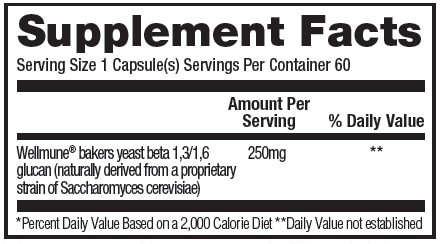

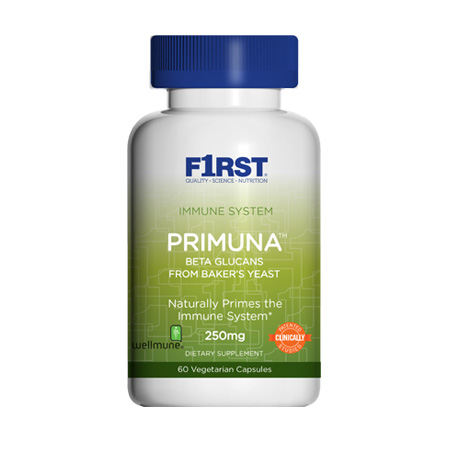
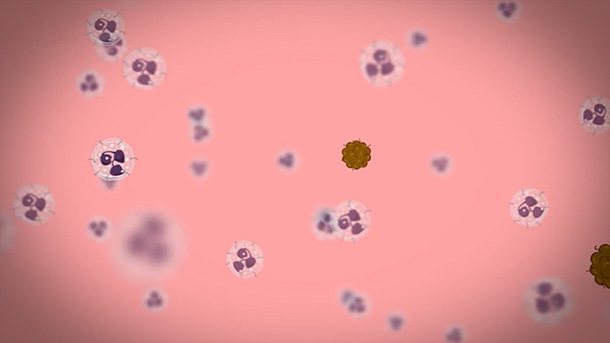


 Occasional stress on the immune system can come from many sources, psychological stress, and physical stress including intense exercise. Stress can impact the immune system, and Primuna can help.
Occasional stress on the immune system can come from many sources, psychological stress, and physical stress including intense exercise. Stress can impact the immune system, and Primuna can help.